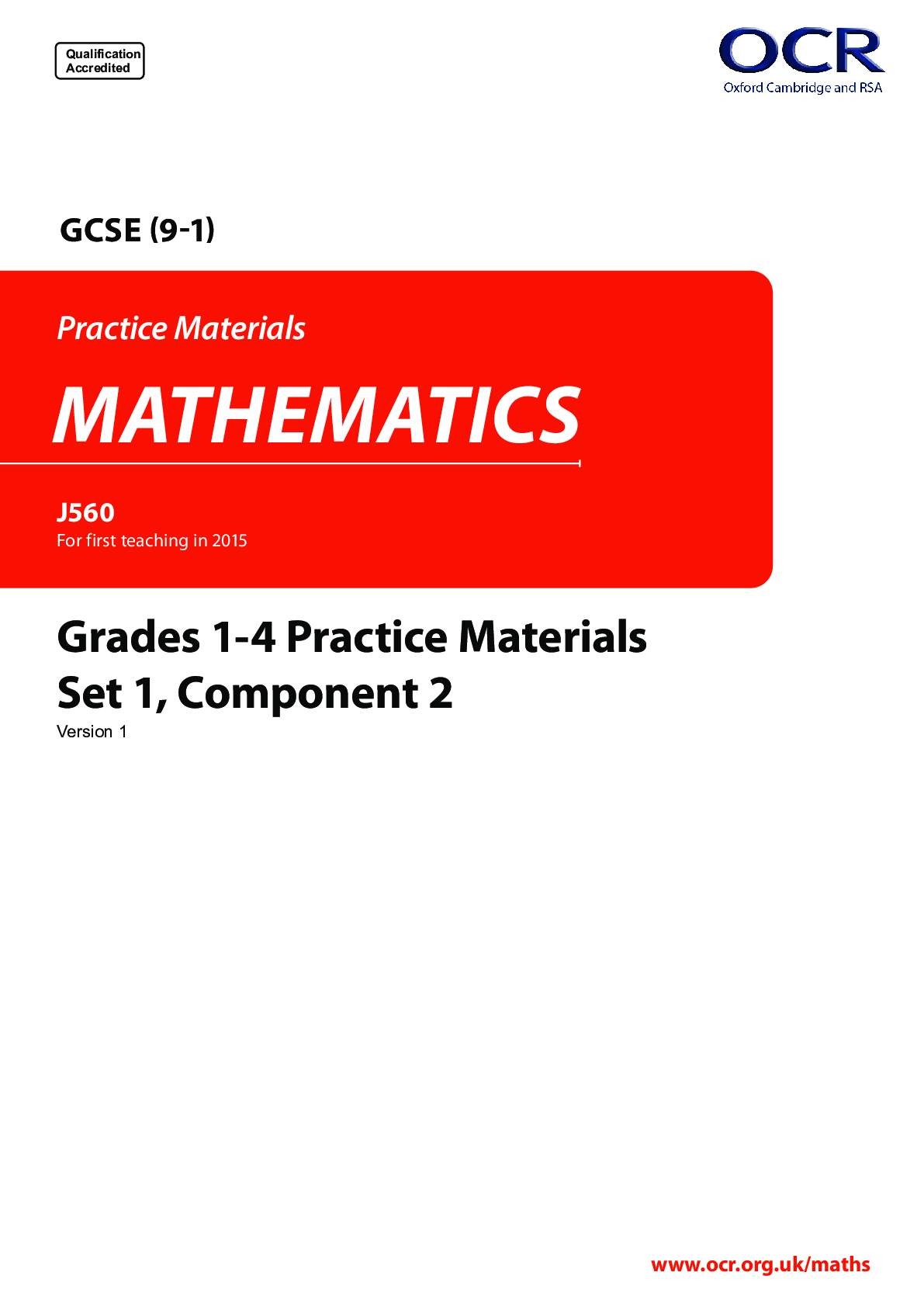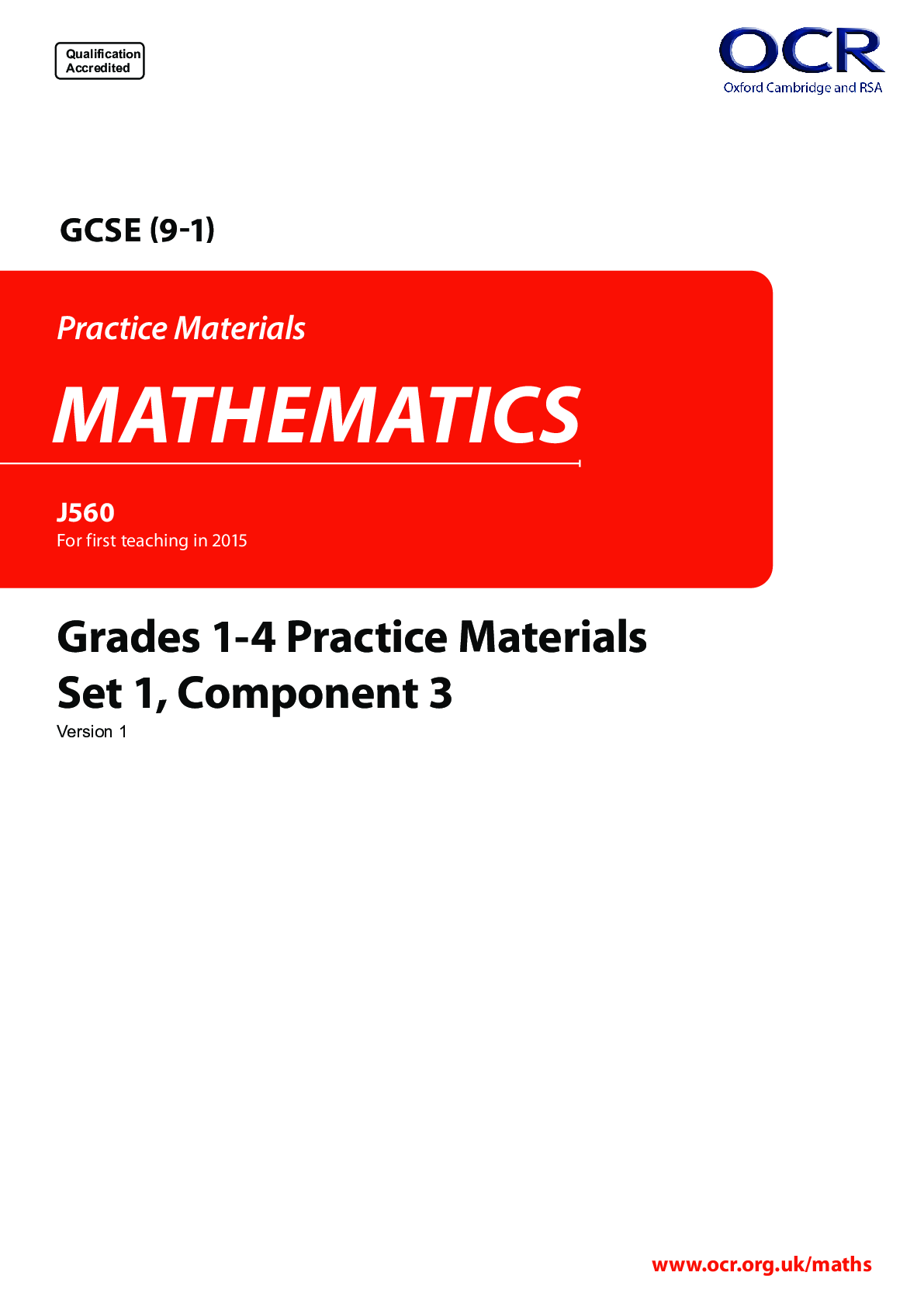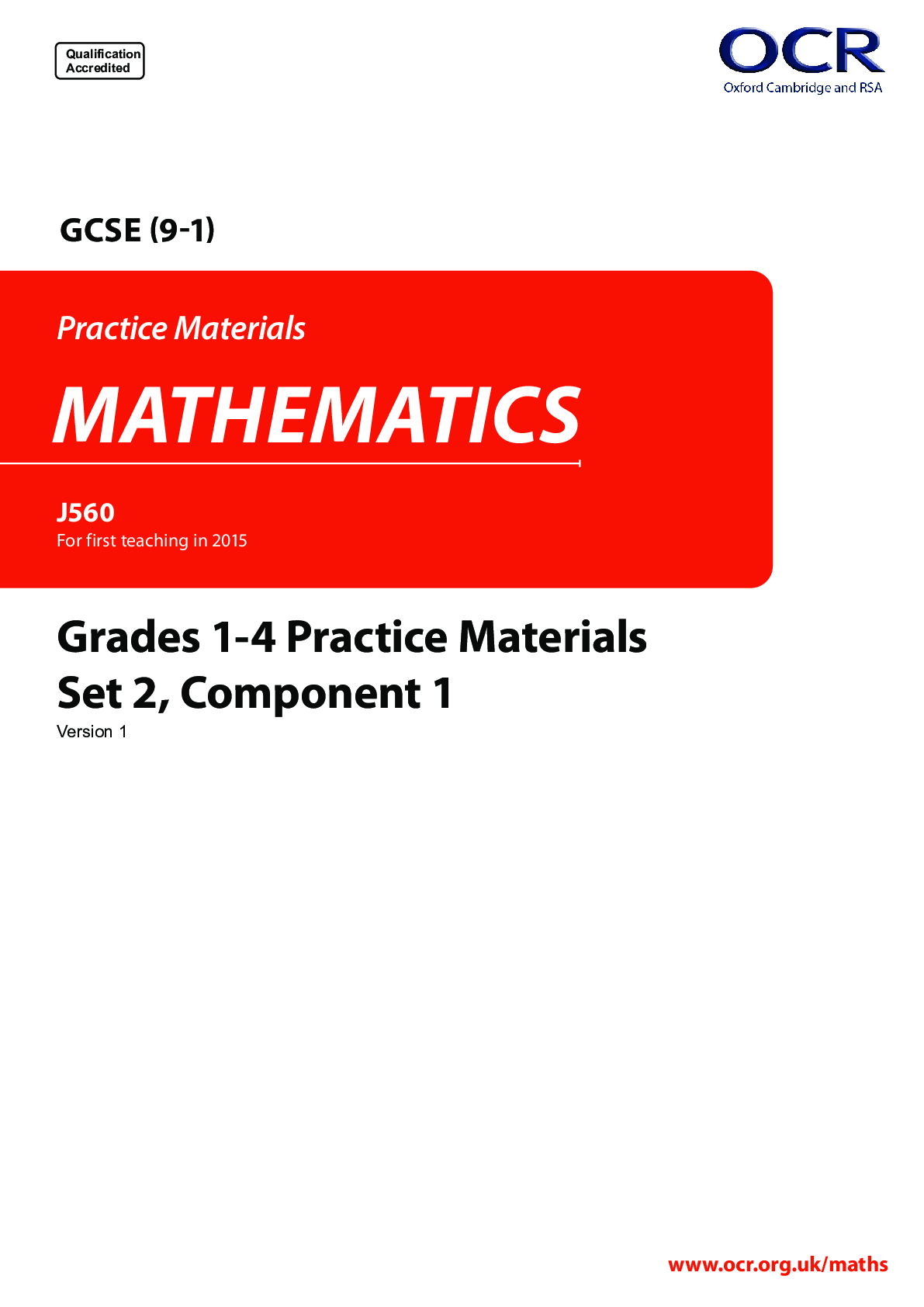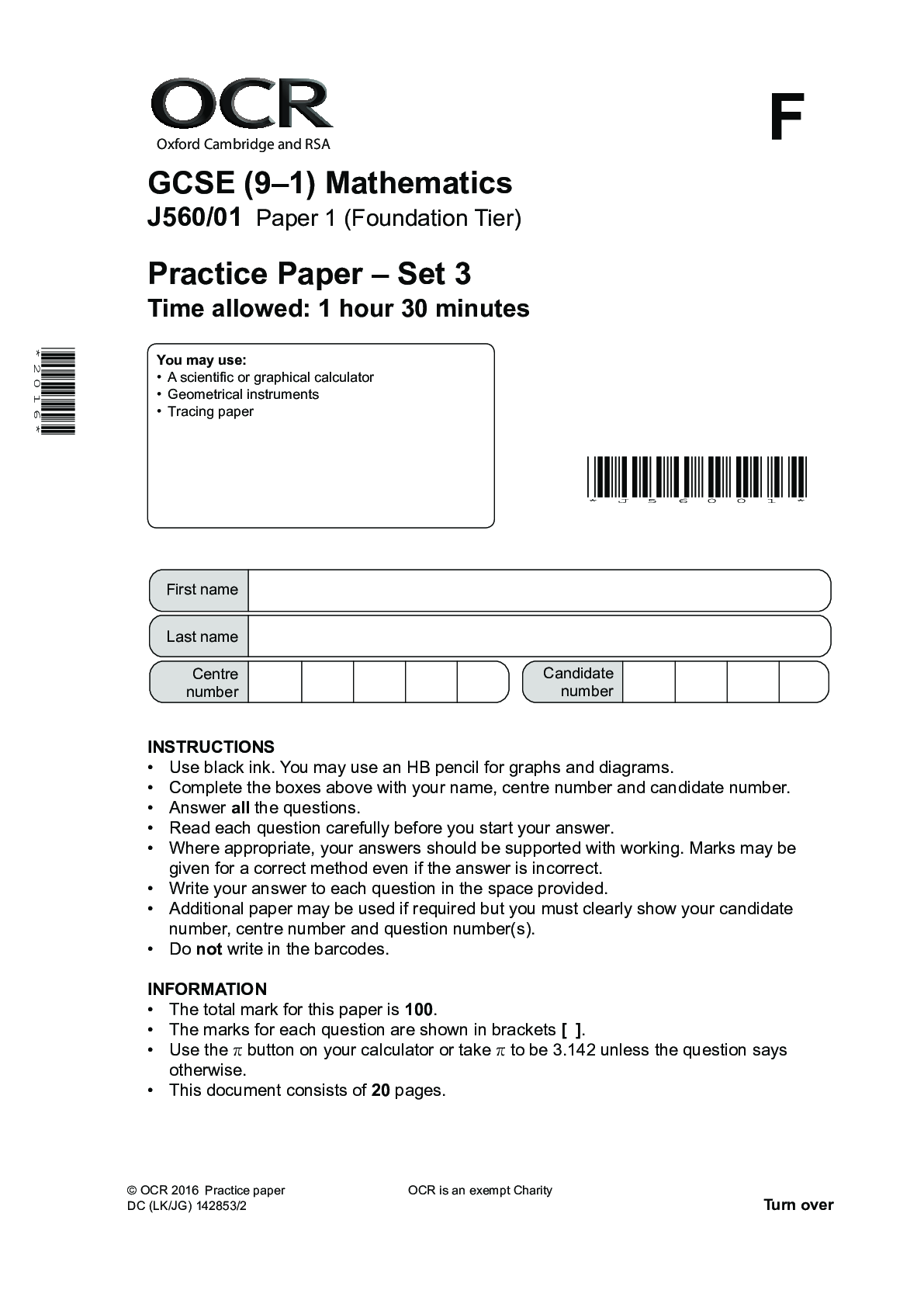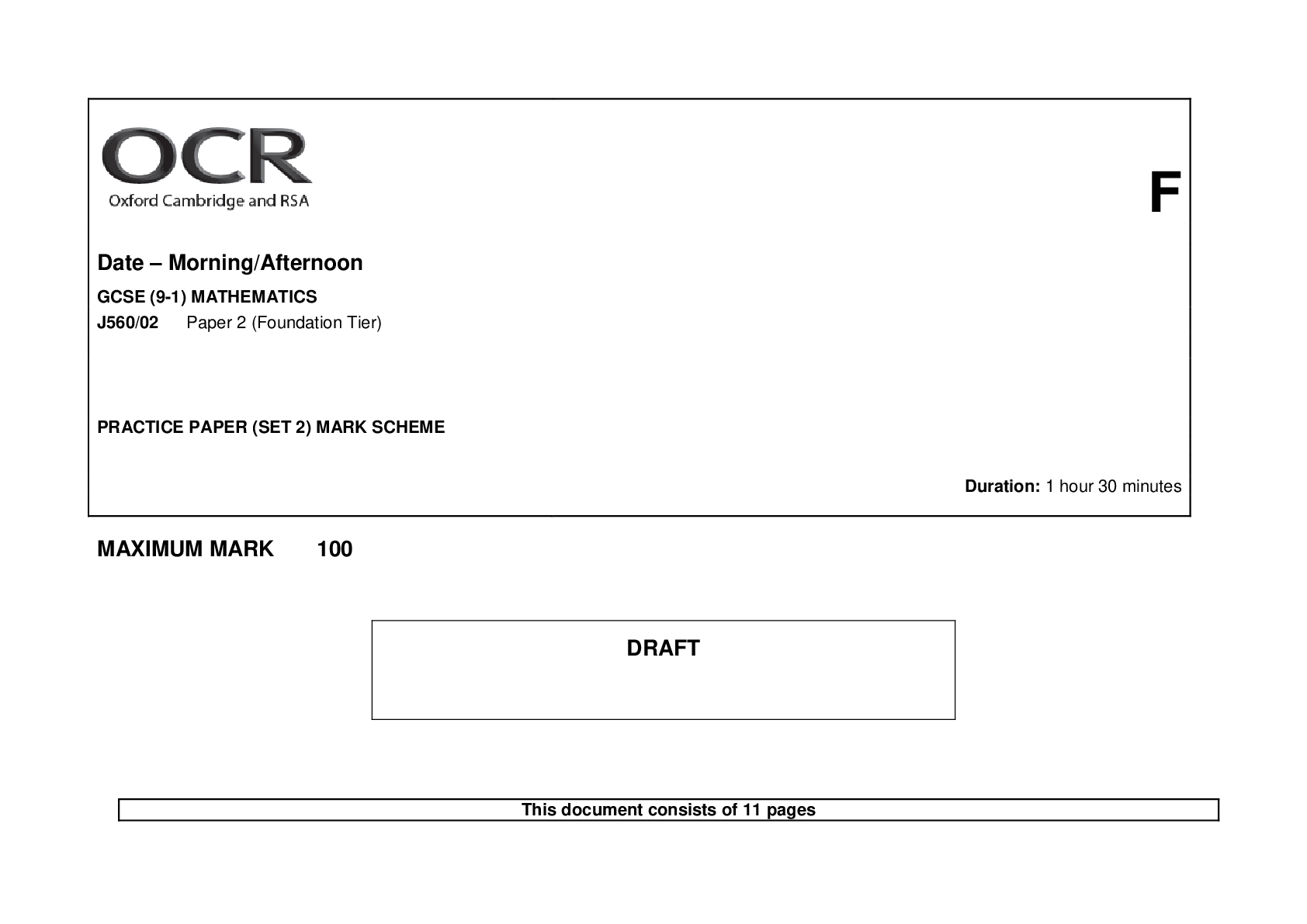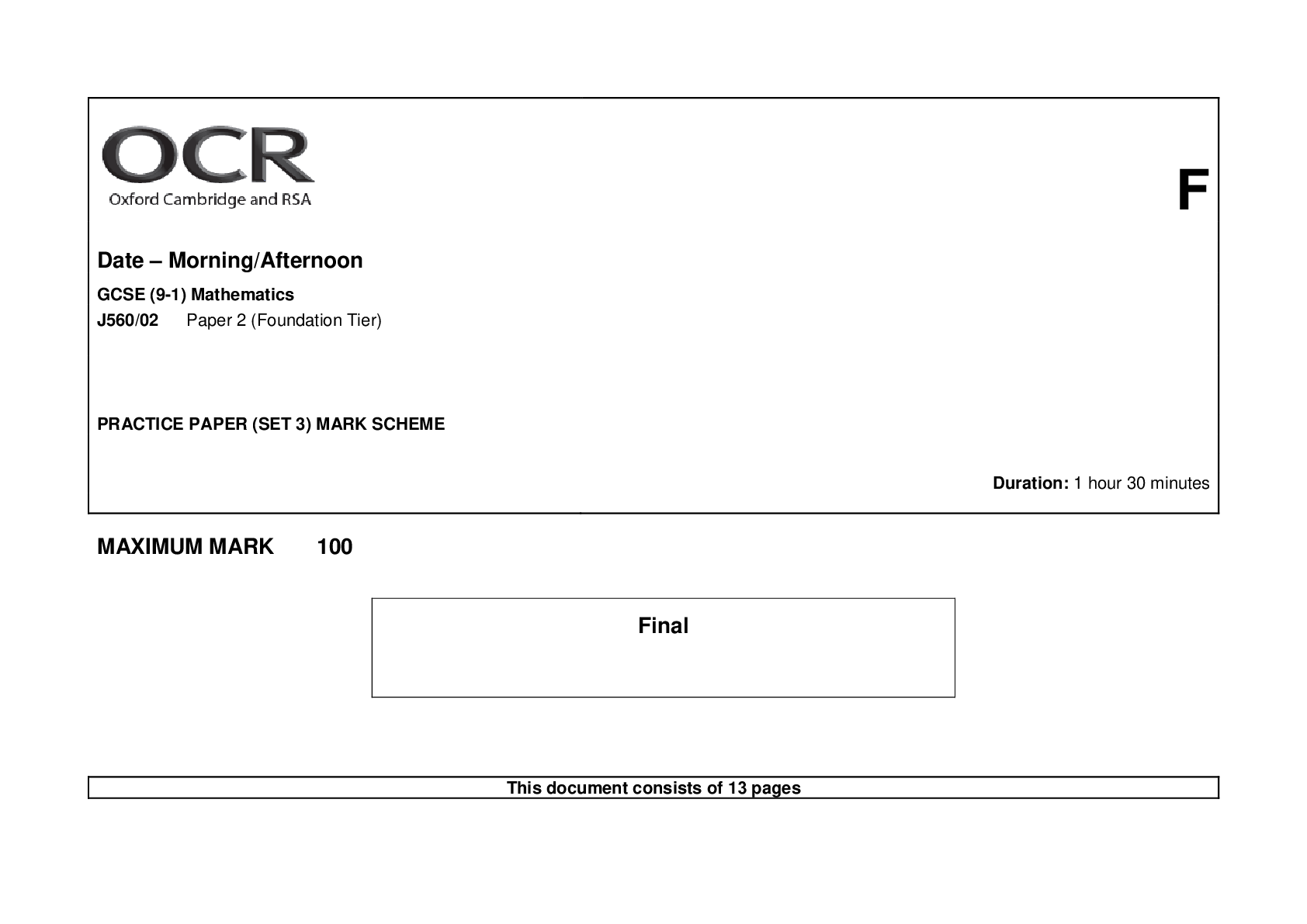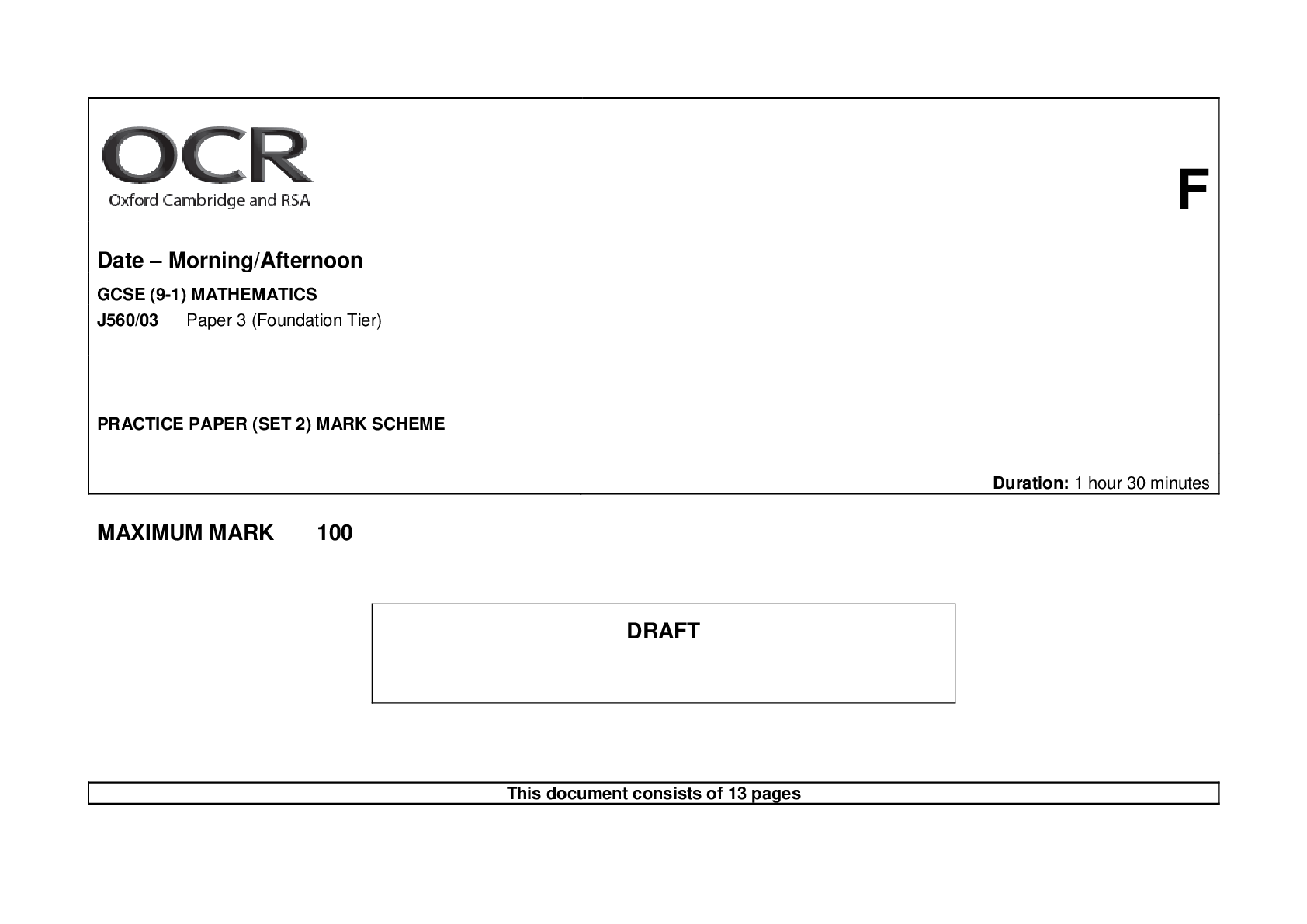Mathematics > Test Prep > GCSE (9–1) Mathematics J560/03: Paper 3 (Foundation tier) General Certificate of Secondary Educati (All)
GCSE (9–1) Mathematics J560/03: Paper 3 (Foundation tier) General Certificate of Secondary Education Mark Scheme for November 2020
Document Content and Description Below
GCSE (9–1) Mathematics J560/03: Paper 3 (Foundation tier) General Certificate of Secondary Education Mark Scheme for November 2020 Oxford Cambridge and RSA Examinations F GCSE (9–1) Math... ematics J560/03: Paper 3 (Foundation tier) General Certificate of Secondary Education Mark Scheme for November 2020Oxford Cambridge and RSA Examinations OCR (Oxford Cambridge and RSA) is a leading UK awarding body, providing a wide range of qualifications to meet the needs of candidates of all ages and abilities. OCR qualifications include AS/A Levels, Diplomas, GCSEs, Cambridge Nationals, Cambridge Technicals, Functional Skills, Key Skills, Entry Level qualifications, NVQs and vocational qualifications in areas such as IT, business, languages, teaching/training, administration and secretarial skills. It is also responsible for developing new specifications to meet national requirements and the needs of students and teachers. OCR is a not-for-profit organisation; any surplus made is invested back into the establishment to help towards the development of qualifications and support, which keep pace with the changing needs of today’s society. This mark scheme is published as an aid to teachers and students, to indicate the requirements of the examination. It shows the basis on which marks were awarded by examiners. It does not indicate the details of the discussions which took place at an examiners’ meeting before marking commenced. All examiners are instructed that alternative correct answers and unexpected approaches in candidates’ scripts must be given marks that fairly reflect the relevant knowledge and skills demonstrated. Mark schemes should be read in conjunction with the published question papers and the report on the examination. © OCR 2020J560/03 Mark Scheme November 2020 2 1. Annotations available in RM Assessor. These must be used whenever appropriate during your marking. Annotation Meaning Correct Incorrect Benefit of doubt Follow through Ignore subsequent working (after correct answer obtained), provided method has been completed Method mark awarded 0 Method mark awarded 1 Method mark awarded 2 Accuracy mark awarded 1 Independent mark awarded 1 Independent mark awarded 2 Misread Special case Omission sign Blank page SeenJ560/03 Mark Scheme November 2020 3 For a response awarded zero (or full) marks a single appropriate annotation (cross, tick, M0 or ^) is sufficient, but not required. For responses that are not awarded either 0 or full marks, you must make it clear how you have arrived at the mark you have awarded and all responses must have enough annotation for a reviewer to decide if the mark awarded is correct without having to mark it independently. It is vital that you annotate standardisation scripts fully to show how the marks have been awarded. Subject-Specific Marking Instructions 2. M marks are for using a correct method and are not lost for purely numerical errors. A marks are for an accurate answer and depend on preceding M (method) marks. Therefore M0 A1 cannot be awarded. B marks are independent of M (method) marks and are for a correct final answer, a partially correct answer, or a correct intermediate stage. SC marks are for special cases that are worthy of some credit. 3. The following abbreviations are commonly found in GCSE Mathematics mark schemes. - figs 237, for example, means any answer with only these digits. You should ignore leading or trailing zeros and any decimal point e.g. 237000, 2.37, 2.370, 0.00237 would be acceptable but 23070 or 2374 would not. - isw means ignore subsequent working after correct answer obtained and applies as a default. - nfww means not from wrong working. - oe means or equivalent. - rot means rounded or truncated. - soi means seen or implied. - dep means that the marks are dependent on the marks indicated. You must check that the candidate has met all the criteria specified for the mark to be awarded. - with correct working means that full marks must not be awarded without some working. The required minimum amount of working will be defined in the guidance column and SC marks given for unsupported answers. 4. Anything in the mark scheme which is in square brackets […] is not required for the mark to be earned, but if present it must be correct. 5. Unless the command word requires that working is shown and the working required is stated in the mark scheme, then if the correct answer is clearly given and is not from wrong working full marks should be awarded. Do not award the marks if the answer was obtained from an incorrect method, i.e. incorrect working is seen and the correct answer clearly follows from it.J560/03 Mark Scheme November 2020 4 6. Where follow through (FT) is indicated in the mark scheme, marks can be awarded where the candidate’s work follows correctly from a previous answer whether or not it was correct. For questions with FT available you must ensure that you refer back to the relevant previous answer. You may find it easier to mark these questions candidate by candidate rather than question by question. Figures or expressions that are being followed through are sometimes encompassed by single quotation marks after the word their for clarity, e.g. FT 180 × (their ‘37’ + 16), or FT 300 – √(their ‘52 + 72’). Answers to part questions which are being followed through are indicated by e.g. FT 3 × their (a). 7. In questions with no final answer line, make no deductions for wrong work after an acceptable answer (i.e. isw) unless the mark scheme says otherwise, indicated by the instruction ‘mark final answer’. 8. In questions with a final answer line and incorrect answer given: (i) If the correct answer is seen in the body of working and the answer given on the answer line is a clear transcription error allow full marks unless the mark scheme says ‘mark final answer’. Place the annotation next to the correct answer. (ii) If the correct answer is seen in the body of working but the answer line is blank, allow full marks. Place the annotation next to the correct answer. (iii) If the correct answer is seen in the body of working but a completely different answer is seen on the answer line, then accuracy marks for the answer are lost. Method marks could still be awarded if there is no other method leading to the incorrect answer. Use the M0, M1, M2 annotations as appropriate and place the annotation next to the wrong answer. 9. In questions with a final answer line: (i) If one answer is provided on the answer line, mark the method that leads to that answer. A correct step, value or statement that is not part of the method that leads to the given answer should be awarded M0 and/or B0. (ii) If more than one answer is provided on the answer line and there is a single method provided, award method marks only. (iii) If more than one answer is provided on the answer line and there is more than one method provided, award marks for the poorer response unless the candidate has clearly indicated which method is to be marked. 10. In questions with no final answer line: (i) If a single response is provided, mark as usual.J560/03 Mark Scheme November 2020 5 (ii) If more than one response is provided, award marks for the poorer response unless the candidate has clearly indicated which response is to be marked. 11. When the data of a question is consistently misread in such a way as not to alter the nature or difficulty of the question, please follow the candidate’s work and allow follow through for A and B marks. Deduct 1 mark from any A or B marks earned and record this by using the MR annotation. M marks are not deducted for misreads. If a candidate corrects the misread in a later part, do not continue to follow through, but award A and B marks for the correct answer only. 12. Unless the question asks for an answer to a specific degree of accuracy, always mark at the greatest number of significant figures even if this is rounded or truncated on the answer line. For example, an answer in the mark scheme is 15.75, which is seen in the working. The candidate then rounds or truncates this to 15.8, 15 or 16 on the answer line. Allow full marks for the 15.75. 13. Ranges of answers given in the mark scheme are always inclusive. 14. For methods not provided for in the mark scheme give as far as possible equivalent marks for equivalent work. If in doubt, consult your Team Leader. 15. If in any case the mark scheme operates with considerable unfairness consult your Team Leader.J560/03 Mark Scheme November 2020 6 Question Answer Marks Part marks and guidance 1 a One from 1, 2, 4, 10 or 20 1 If more than one, all must be correct b Any multiple of 20 1 If more than one, all must be correct Answer 5 × 4 = 20 scores 0 2 a 25 1 b i 12 1 ii 8 1 3 Incorrect oe and [2 – 3 × 2 =] -4 and [3 – 5 =] -2 2 B1 for [2 – 3 × 2 =] -4 or 3 – 5 = -2 or -2 associated with 3 – 5 Both answers are -2 scores B1 Incorrect because the answers are different scores 0 4 a 110 1 b i 1 1 b ii Median [because] All but one score is close to 3 oe 1 Allow, it is not distorted by (the high value or 111) oe Accept 3 for Median Must mention or imply clustering or distortion See Appendix 5 a Cylinder 1 Condone poor spelling b [square-based] pyramid or octahedron 1 Condone poor spellingJ560/03 Mark Scheme November 2020 7 Question Answer Marks Part marks and guidance 6 a 35 2 M1 for 50 × 0.7 oe Answer 35% implies M1 For M1 accept correct noncalculator methods that show operations See Appendix b 7 10 or equivalent fraction 2 B1 for 3 10 oe or answer 0.7 or 70% B1 may be implied by e.g.0.3 or 21 70 etc but not × 3 ÷ 10 c Correct fraction 2 M1 for common denominator of form 7n where n is integer > 1 or for 0.428[5...] and 0.571[4...] or 42.8[5...]% and 57.1[4...]% or 3 4 2 7 7 + ÷ For 2 marks, Ignore attempts to cancel once correct answer seen but not to change to decimal or percentage. May be 0.429 May be 42.9% Possible correct answers are 1 2 or 7 14 or 10 21 or 11 21 etcJ560/03 Mark Scheme November 2020 8 Question Answer Marks Part marks and guidance 7 (-2, 4) 3 B1 for [a length =] 6 soi M1 for square or partial square anchored on (4, -2) and fitting entirely on the grid or two or three plots only that define a square anchored on (4, -2) or attempt ± − 4 6 2 6 If 0 scored, SC1 for answer (-3, 5) or (-1, 3) or (0, 2) or (1, 1) or (2, 0) or (3, -1) or (5, -3) e.g. line from A to (-2, -2) or (4, 4) At least two connected sides A suitable square side 6 anchored on (4, -2) scores B1M1 Square need not be drawn some working to be seen for “attempt” e.g. 4 – 6 and −2 + 6J560/03 Mark Scheme November 2020 9 Question Answer Marks Part marks and guidance 8 a 18 515 4 M3 for 7 × 2300 × 1.15 oe or M2 for 2300 × 1.15 oe soi 2645 or 7 × 2300 × 0.15 soi 2415 or M1 for 2300 × 0.15 oe soi 345 or 7 × 2300 soi 16100 oe may be ÷ 100 and × 115. If non calculator method then must see operations to award M unless implied by correct value. See Appendix b 7 3 M2 for 63 ÷ 9 OR M1 1 9 : 10 10 = x : 63 oe soi or B1 for 9 10 or 0.9 or 9 or 7 seen Alternative: M2 for 63 ÷ [0].9 – 63 oe or M1 for 63 ÷ [0].9 oe For M1 Accept 1 : 9 = x : 10 9 Incorrect oe supported by full correct evidence and 1 3 or Incorrect oe supported by full correct evidence and 2 3 not equal 2 6 oe 3 M2 for GB, GG, GR, RB, RG, RR oe only and 2 6 or M1 for 5 or 6 correct pairs shown [and one wrong or repeat] or [There are] six pairs [with] two matching [so P =] 1 3 ” oe oe correct, annotated tree diagram isw attempt to cancel once 2 6 seen For M1 ignore any fractions and mark only listsJ560/03 Mark Scheme November 2020 10 Question Answer Marks Part marks and guidance 10 [Bank] A and 4 with correct working 5 M1 for 280 ÷ 250 soi 1.12 or 0.12 M1 for 400 × their 1.12 oe soi 448 M1 for 452 – their 448 A1 dep for their A OR M1 for 280 ÷ 250 soi 1.12 M1 for 452 ÷ 400 soi 1.13 M1 for (their 1.13 – their 1.12) × 400 A1dep for their A If 0 or M1 scored, SC2 for A and 4 or If 0 scored, SC1 for their A and wrong difference with subtraction seen Correct working requires at least M2 Accept 12% [of 250] seen. oe 0.12 × 400 = 48, 400 + 48 A1 for [Bank] A is dep M3 their A is correct bank from identified 452 – their 448 ALTERNATIVE FORM OF METHOD Reduction to common amount ≠ 1 Marks only for e.g. 50 common M1 for 250 ÷ 5 and 280 ÷ 5 (50/56) M1 for 400 ÷ 8 and 452 ÷ 8 (50/56.5) M1 for (their 56.5 – their 56) × 8 A1 for [Bank] A is dep M3 their A is correct bank from identified (their 1.13 – their 1.12) × 400 If there is evidence for M1 only and SC2 is available, award only SC2 A value for A – a value for B seen or A value for B – a value for A seenJ560/03 Mark Scheme November 2020 11 Question Answer Marks Part marks and guidance 11 c = 2 final answer d = -3 final answer 5 B3 for c = 2 and B2 for d = -3 OR M4 for 5 + 2d = -1 oe or M3 for 10 + c = 12 or 5 + cd = -1 or 10x + cx = 12x or M2 for 10x + 5 + cx + cd [= 12x – 1] oe or M1 for 10x + 5 or cx + cd Must not come from wrong working Accept e.g. d2 or 2×d etc for 2d e.g. 10x + cx + cd = 12x – 6 12 a i 6 1 ii -5 1 b -1 2 B1 for 1 = 20 or M1 for 2y = 1 2 or 21 + y = 20 or 1 + y = 0 or 2 × 2-1 = 1 B1 Implied by 2 × 2y = 20J560/03 Mark Scheme November 2020 12 Question Answer Marks Part marks and guidance 13 a Straight line from (0, 0) with positive gradient 2 B1 for straight line with positive gradient or a series of crosses in a straight line that would pass through (0, 0) Intercept within 1mm of (0, 0) (“centre of line” inside circle of overlay) For 1 or 2 marks, intended straight Ignore scale on axes At least three crosses b i 36 3 M2 for 432 ÷ 120 × 10 oe or M1 for 432 ÷ 120 soi 3.6 or 120 ÷ 10 soi 12 e.g. 432 ÷ 12 120+120+120+60 = 420 oe ii 1640 3 B1 for [2 kg =] 2000 seen M1 for 100 × their36 10 or 10 × their 36 B1 may be awarded for the conversion even if not used in method May be 10 × their 36 correctly evaluated or 360 seenJ560/03 Mark Scheme November 2020 13 Question Answer Marks Part marks and guidance 14 a Points plotted at (210, 130) and (100, 80) 2 B1 for 100 soi or for one point plotted correctly Half square tolerance May be implied by point plotted at duration 100 b Point at (220, 64) circled 1 c i Ruled line of best fit drawn 1 Use overlay anchored on top right point Line must reach to edges of overlay c ii Their line used to give duration for £90 ± 5 minutes 1 FT Strict FT from their intended straight line of best fit NB read (n, 90) not (90, n) d [7 hours is] is beyond the given data oe 1 Accept eg the trend may not continue 15 16.5 4 B3 for 5.5 [cm] nfww or M2 for 3x + x + 3x + x = 44 or better or 44 ÷ 8 oe or M1 for 3x [as length] and x [as width] or 4x [as length + width] or 8x [as perimeter] OR Using trial length and width with length = 3 × width M1 for a perimeter found M1 for a second perimeter closer to 44 If 0 scored SC1 for answer 33 May be other letters or in words for 2 or 1 mark 3x and x may be on diagramJ560/03 Mark Scheme November 2020 14 Question Answer Marks Part marks and guidance 16 x < 5 AND 4 B2 for x < 5 or M1 for 3x < 19 – 4 or better AND B2FT for x < 5, or their inequality, correctly shown or B1 for x < 5, or their inequality, correctly shown with a hollow circle and wrong arrow or filled circle and correct arrow Solution to inequality: Allow M1 for this expression with other inequality symbols or equals sign or [x =] 5 as solution (can be implied by mark/circle on the diagram) or trials leading to selection of 5 or final correct trial using 5 Displaying the solution: Display must show an inequality that fits on the number line for FT Mark to candidate’s advantage either x < 5 or their inequality Accept an arrow of any length or a line reaching 1 If no solution to inequality seen: Hollow circle at 5 arrow to left M1B2 Filled circle at 5 arrow to left M1B1 Hollow circle at 5 arrow to right M1B1 Filled circle at 5 arrow to right M1B0 Mark at 5 no line or arrow M1B0 Circle and/or arrow at other than 5 M0B0J560/03 Mark Scheme November 2020 15 Question Answer Marks Part marks and guidance 17 2.25 nfww 5 B2 for 36 or M1 for 9 8 × 2 AND M2 for 1 2 × (12 + 20) × h = their area of triangle oe or M1 for 1 2 × (12 + 20) × h oe 8 × 9 = 72 then 72 ÷ (20 + 12) = 2.25 is wrong working May be in stages Allow (their area of triangle) ÷ 16 or better e.g. 36 ÷ 16 or72 ÷ 32 for M2 M2 and M1 may have area in stages e.g. 12h + 8h 2 (rectangle + one or two triangles) May be two trials approaching their area of triangle or one correct trial with 2.25 May be 16h or one trial with value for h substituted to attempt their area of triangle 18 5.39[6...] or 5.4[0] 3 M2 for 8 × tan34 or any complete correct method or M1 for tan34 = x 8 e.g. − 8 tan(90 34) e.g. 8x tan(90 34) − = See appendixJ560/03 Mark Scheme November 2020 16 Question Answer Marks Part marks and guidance 19 (a) 30 final answer 2 B1 for 150 or 30 seen or M1 for 360 ÷ 12 oe e.g. 180 10 180 12 × − (b) 150 or FT(180 – (a)) 1 Only allow FT if 0 < their (a) < 180J560/03 Mark Scheme November 2020 17 Question Answer Marks Part marks and guidance 20 385 with correct working 6 M2 for [mass of one panel =] 2.4 × 1.2 × 0.018 × 750 or 240 × 120 × 1.8 × 0.750 or M1 for figs 24 × figs 12 × figs 18 × figs 750 or 2.4 × 1.2 × 0.018 or 240 × 120 × 1.8 AND B1 for 15000 [kg] or 15000000g seen or their mass correctly converted to tonnes M1 for ���� 15 �ℎ��� ���� A1 for 385.[…] to 387 If 0 or B1 scored instead award SC2 for answer 385 with no or insufficient working or SC1 for answer 385.[…] to 387 with no working “Correct working” requires evidence of at least M2 AND B1 i.e. correct and consistent units used soi by 38.8 to 38.9 [kg] soi by 38800 to 38900 [g] soi by 0.0518 to 0.0519 [m3] soi by 51800 to 51900 [cm3] Assume their mass unit from M2, but do not assume from M1 only Accept any figure but not 2.4, 1.2, 1.8 and 750 for their mass For M1 accept one or more trial(s) of their mass × an integer in attempt to = their figs 15J560/03 Mark Scheme November 2020 18 Question Answer Marks Part marks and guidance 21 (a) �−42� 2 B1 for 1 component correct If 0 scored, SC1 for �−42� or −42 or (4. −2) Penalise first appearance of vinculum or poor form in vector but condone second use (b) �19 4� oe 2 B1 for 1 component correct or �4 9� seen 22 a 2 0 2 B1 for each b Correct curve 3 B2FT for all points correctly plotted or B1FT for 4 or 5 points correctly plotted FT their values from the table in (a) for points but accept only the correct curve. Accuracy ± half small square Correct curve must have at least one square of daylight below x-axis at minimum point and not intended straight c -[0].4 and 2.4 2 Correct answer or FT their graph for both B1 for each -0.45 to -0.35 and 2.35 to 2.45 FT from their line with half square accuracy (may be straight)J560/03 Mark Scheme November 2020 19 Question Answer Marks Part marks and guidance 23 a 0.12 oe isw 2 M1 for 0.6 × 0.2 Ignore attempts to change form once correct answer seen. Accept 12% or 12 100 or equivalent fraction b 0.6 oe isw 3 M2 for 0.4 × 0.3 + 0.6 × 0.8 or M1 for 0.4 × 0.3 or 0.6 × 0.8 Accept 60% or equivalent fraction Ignore attempts to change form once correct answer seen. 0.12 could come from (a) so calculation must be seen for M2 May be implied by 0.48 APPENDIX Exemplar responses for Q4b(ii) Response Mark Mode. It is the most common number of pets Defines mode 0 Median It’s the middle number Defines median 0 Mean It would include all the numbers Doesn’t recognise distortion 0 3 We don’t include 111 in the calculation. It’s an anomaly Doesn’t mention distortion 0 Median It is a realistic figure Doesn’t say why it is realistic 0 Median [It’s the more realistic average as] most pupils are closest to 3 than the rest Implies clustering 1 3 Most of the numbers are near this Accept 3 for Median (and imply Mode from 1) 1J560/03 Mark Scheme November 2020 20 Exemplar responses for Q6a Non calculator methods. Where non calculator methods are used then the full method must be seen to give M1 This either shows the operations being used at each stage or a complete description of the method with correct values at each stage. e.g. 50 ÷ 10 = n n × 7 50 ÷ 100 = n n × 70 100% → 50 1% → 0.5 ÷ 100 70% → 35 × 50 100% → 50 1% → 0.5 70% → 35 100% → 50 1% → 0.05 70% → 0.35 n can be incorrect but operations seen so M1 n can be incorrect but operations seen so M1 “→” may be “of 50” or “is” or “=” or missed out Values can be incorrect as operations seen. M1 “→” may be “of 50” or “is” or “=” or missed out Values must be correct as no operations seen: M1 “→” may be “of 50” or “is” or “=” or missed out Values incorrect. As no operations seen: M0 Exemplar responses for 8a 8a Non calculator methods. e.g. 2300 ÷ 100 = n n × 115 (or 2300 + n × 15) 2300 ÷ 100 = n n × 15 100% → 2300 1% → 23 ÷ 100 115% → 2645 × 115 100% → 2300 1% → 23 15% → 345 115% → 2300 + 345 100% → 2300 1% → 25 15% → 375 115% → 2675 n can be incorrect but operations seen so M2 n can be incorrect but operations seen so M1 “→” may be “of 2300” or “is” or “=” or missed out Values can be incorrect as operations seen. M2 “→” may be “of 2300” or “is” or “=” or missed out Values must be correct as no operations seen: M2 If stopping at line 3 or next step incorrect then M1 “→” may be “of 2300” or “is” or “=” or missed out Values incorrect. As no operations seen: M0 If a candidate successfully demonstrates a step in the method the marks are awarded, even if they then misuse the stepJ560/03 Mark Scheme November 2020 21 However, if the method is embedded in other, wrong steps, so there is no clear step shown from the scheme, the mark is not awarded. Exemplar responses for Q10 Response Mark ALTERNATIVE METHOD M1 for 250 ÷ 5 = 50 and 280 ÷ 5 = 56 M1 for 400 ÷ 8 = 50 and 452 ÷ 8 = 56.5 M1 for 0.5 × 8 This is fine as the two amounts are reduced to a common amount of 50 3 M0 for 250 ÷ 5 = 50 and 280 ÷ 5 = 56 M0 for 400 ÷ 10 = 40 and 452 ÷ 10 = 45.2 M0 for (45.2 – 40) × 10 This scores no marks as the amounts reduced to are not common. We must consider the whole method to be able to award marks 0J560/03 Mark Scheme November 2020 22 Exemplar responses for Q14d Response Mark No because it does not have a record for 7 hours This scores 0 as there is no record for e.g. 80 min. Must imply “beyond” 0 7 hours isn't on the scale. No. Implies a bigger diagram would be OK 0 No Because 420 minutes is too long to fit on the graph Implies it would be OK with a bigger graph 0 No It only shows 2h 50 minutes Suggests 7 hours is a missing value 0 No It would go up to 4200. No. Implies scale not long enough 0 No Highest duration is 250 mins which isn't 7 hours. 420 mins is 7 hours. No. Implies a bigger diagram would be OK 0 No His records only go up to 4hours 10minutes. No. This is about the scale. However, if they had said 4 hours, then they would have been talking about the data 0 No It does not show this information. 7x60 = 420mins. Graph only goes up to 250 mins. No...scale again 0 No His record doesn't show any 7 hour flights. No. Implies it is a missing value 0 No It would not fit on the graph. No. Implies a bigger diagram would be OK 0 No Duration only goes to 250 mins. No. Implies a bigger diagram would be OK 0 No Graph does not go beyond 250 minutes. 60x7 = 420mins. No. Implies a bigger diagram would be OK 0 No Extrapolation Not explained 0 No. The data only shows a maximum of a 250 minute flight so this would be unreliable Contradiction. 240 rather than 250 would have been acceptable. 0 No. Should not extrapolate beyond 250 minutes/the graph Graph not big enough 0 No. Extrapolating too far meaning his estimate would be inaccurate Not quite sufficiently clear. What is “too far” and is it from 240 or 250? 0 No Duration does not go up to 7 hours. No. Implies a bigger diagram would be OK 0 No There are only less amount of flights on the diagram. Yes. This implies “beyond the data” 1 No because the duration only goes up to 240 minutes Scores the mark for implying beyond the data 1 No because it does not have records that go as far as 7 hours. This is OK as it implies “beyond” 1 No. Should not extrapolate beyond 240 minutes/the data Beyond the data 1J560/03 Mark Scheme November 2020 23 Exemplar responses for Q18 Response Mark For longest method M1 is for step before explicit calculation for answer cos 34 = 8y so y = 8 cos34 so x2 = y 2 cos 34 − 82 M1 For longest method M2 is for explicit calculation for answer cos 34 = 8y so y = 8 cos34 so x 2 8 2 8 cos34 = − M2 Allow e.g. for M1 x tan34 8 M1OCR (Oxford Cambridge and RSA Examinations) The Triangle Building Shaftesbury Road Cambridge CB2 8EA [Show More]
Last updated: 2 years ago
Preview 1 out of 22 pages
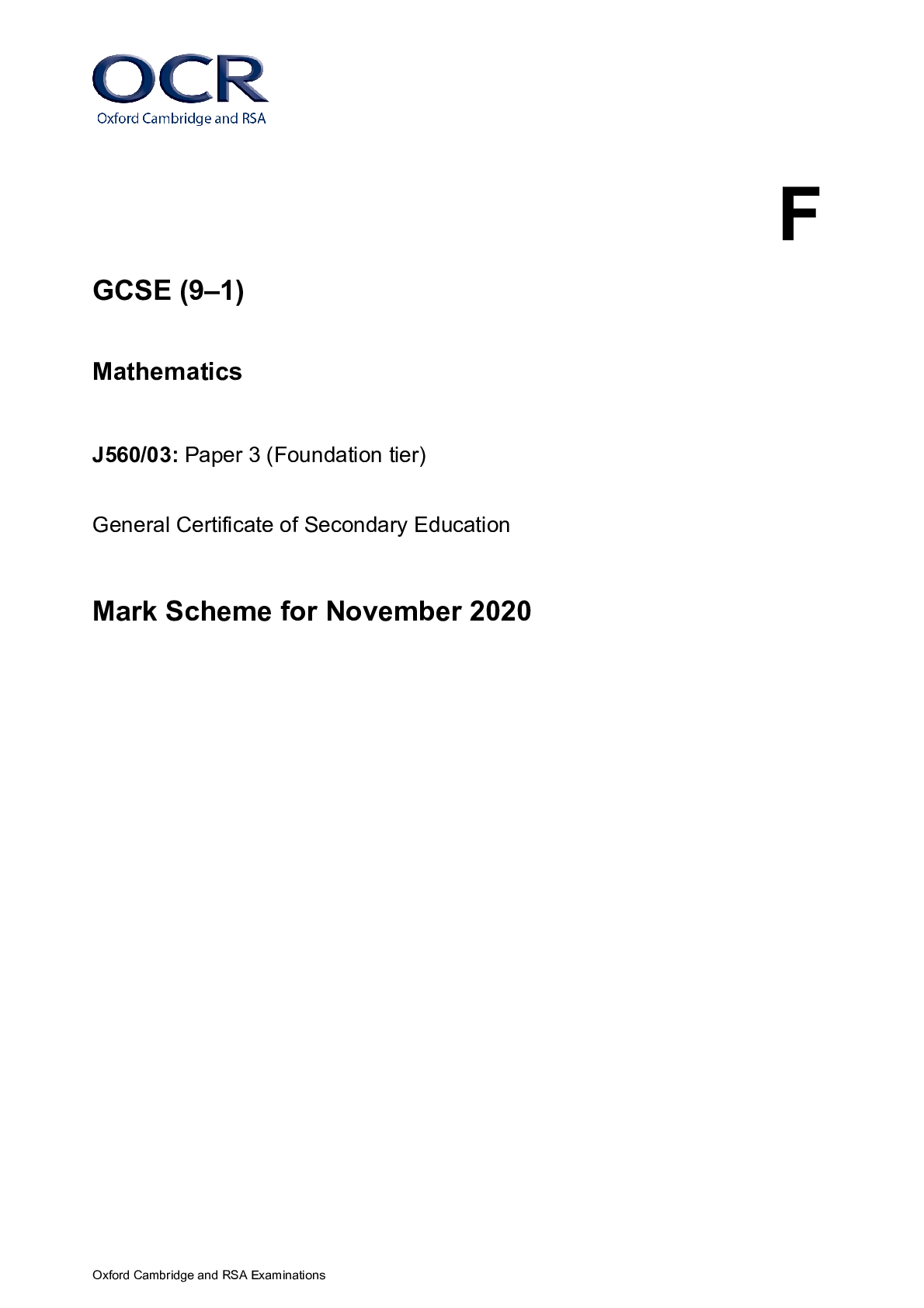
Buy this document to get the full access instantly
Instant Download Access after purchase
Buy NowInstant download
We Accept:

Reviews( 0 )
$7.50
Can't find what you want? Try our AI powered Search
Document information
Connected school, study & course
About the document
Uploaded On
Oct 07, 2022
Number of pages
22
Written in
Additional information
This document has been written for:
Uploaded
Oct 07, 2022
Downloads
0
Views
77

